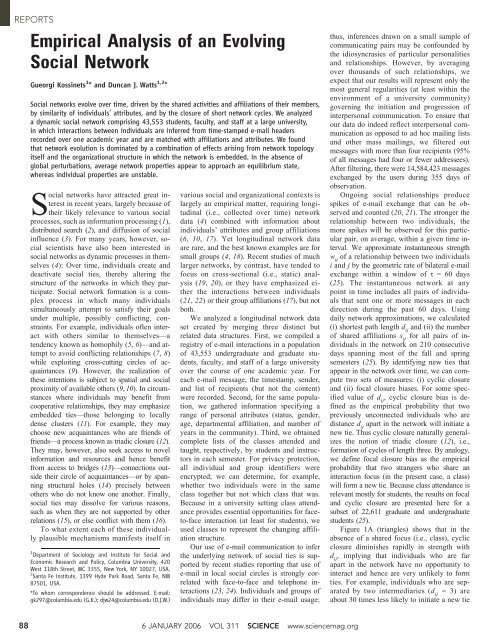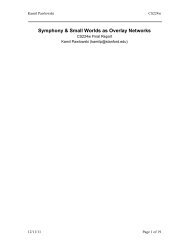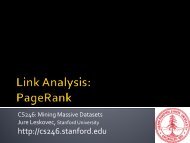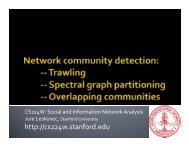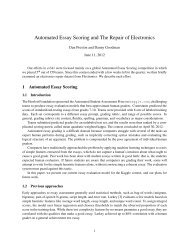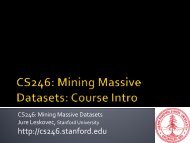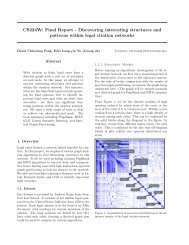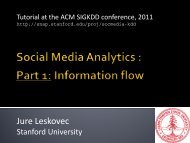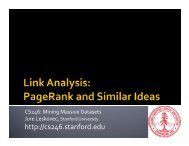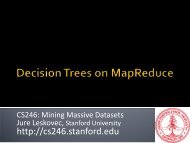Empirical Analysis of an Evolving Social Network - Science
Empirical Analysis of an Evolving Social Network - Science
Empirical Analysis of an Evolving Social Network - Science
Create successful ePaper yourself
Turn your PDF publications into a flip-book with our unique Google optimized e-Paper software.
REPORTS<br />
88<br />
<strong>Empirical</strong> <strong>Analysis</strong> <strong>of</strong> <strong>an</strong> <strong>Evolving</strong><br />
<strong>Social</strong> <strong>Network</strong><br />
Gueorgi Kossinets 1 * <strong>an</strong>d Dunc<strong>an</strong> J. Watts 1,2 *<br />
<strong>Social</strong> networks evolve over time, driven by the shared activities <strong>an</strong>d affiliations <strong>of</strong> their members,<br />
by similarity <strong>of</strong> individuals’ attributes, <strong>an</strong>d by the closure <strong>of</strong> short network cycles. We <strong>an</strong>alyzed<br />
a dynamic social network comprising 43,553 students, faculty, <strong>an</strong>d staff at a large university,<br />
in which interactions between individuals are inferred from time-stamped e-mail headers<br />
recorded over one academic year <strong>an</strong>d are matched with affiliations <strong>an</strong>d attributes. We found<br />
that network evolution is dominated by a combination <strong>of</strong> effects arising from network topology<br />
itself <strong>an</strong>d the org<strong>an</strong>izational structure in which the network is embedded. In the absence <strong>of</strong><br />
global perturbations, average network properties appear to approach <strong>an</strong> equilibrium state,<br />
whereas individual properties are unstable.<br />
<strong>Social</strong> networks have attracted great interest<br />
in recent years, largely because <strong>of</strong><br />
their likely relev<strong>an</strong>ce to various social<br />
processes, such as information processing (1),<br />
distributedsearch(2), <strong>an</strong>d diffusion <strong>of</strong> social<br />
influence (3). For m<strong>an</strong>y years, however, social<br />
scientists have also been interested in<br />
social networks as dynamic processes in themselves<br />
(4): Over time, individuals create <strong>an</strong>d<br />
deactivate social ties, thereby altering the<br />
structure <strong>of</strong> the networks in which they participate.<br />
<strong>Social</strong> network formation is a complex<br />
process in which m<strong>an</strong>y individuals<br />
simult<strong>an</strong>eously attempt to satisfy their goals<br />
under multiple, possibly conflicting, constraints.<br />
For example, individuals <strong>of</strong>ten interact<br />
with others similar to themselves—a<br />
tendency known as homophily (5, 6)—<strong>an</strong>d attempt<br />
to avoid conflicting relationships (7, 8)<br />
while exploiting cross-cutting circles <strong>of</strong> acquaint<strong>an</strong>ces<br />
(9). However, the realization <strong>of</strong><br />
these intentions is subject to spatial <strong>an</strong>d social<br />
proximity <strong>of</strong> available others (9, 10). In circumst<strong>an</strong>ces<br />
where individuals may benefit from<br />
cooperative relationships, they may emphasize<br />
embedded ties—those belonging to locally<br />
dense clusters (11). For example, they may<br />
choose new acquaint<strong>an</strong>ces who are friends <strong>of</strong><br />
friends—a process known as triadic closure (12).<br />
They may, however, also seek access to novel<br />
information <strong>an</strong>d resources <strong>an</strong>d hence benefit<br />
from access to bridges (13)—connections outside<br />
their circle <strong>of</strong> acquaint<strong>an</strong>ces—or by sp<strong>an</strong>ning<br />
structural holes (14) precisely between<br />
others who do not know one <strong>an</strong>other. Finally,<br />
social ties may dissolve for various reasons,<br />
such as when they are not supported by other<br />
relations (15), or else conflict with them (16).<br />
To what extent each <strong>of</strong> these individually<br />
plausible mech<strong>an</strong>isms m<strong>an</strong>ifests itself in<br />
1<br />
Department <strong>of</strong> Sociology <strong>an</strong>d Institute for <strong>Social</strong> <strong>an</strong>d<br />
Economic Research <strong>an</strong>d Policy, Columbia University, 420<br />
West 118th Street, MC 3355, New York, NY 10027, USA.<br />
2<br />
S<strong>an</strong>ta Fe Institute, 1399 Hyde Park Road, S<strong>an</strong>ta Fe, NM<br />
87501, USA.<br />
*To whom correspondence should be addressed. E-mail:<br />
gk297@columbia.edu (G.K.); djw24@columbia.edu (D.J.W.)<br />
various social <strong>an</strong>d org<strong>an</strong>izational contexts is<br />
largely <strong>an</strong> empirical matter, requiring longitudinal<br />
(i.e., collected over time) network<br />
data (4) combined with information about<br />
individuals_ attributes <strong>an</strong>d group affiliations<br />
(6, 10, 17). Yet longitudinal network data<br />
are rare, <strong>an</strong>d the best known examples are for<br />
small groups (4, 18). Recent studies <strong>of</strong> much<br />
larger networks, by contrast, have tended to<br />
focus on cross-sectional (i.e., static) <strong>an</strong>alysis<br />
(19, 20), or they have emphasized either<br />
the interactions between individuals<br />
(21, 22) or their group affiliations (17), but not<br />
both.<br />
We <strong>an</strong>alyzed a longitudinal network data<br />
set created by merging three distinct but<br />
related data structures. First, we compiled a<br />
registry <strong>of</strong> e-mail interactions in a population<br />
<strong>of</strong> 43,553 undergraduate <strong>an</strong>d graduate students,<br />
faculty, <strong>an</strong>d staff <strong>of</strong> a large university<br />
over the course <strong>of</strong> one academic year. For<br />
each e-mail message, the timestamp, sender,<br />
<strong>an</strong>d list <strong>of</strong> recipients (but not the content)<br />
were recorded. Second, for the same population,<br />
we gathered information specifying a<br />
r<strong>an</strong>ge <strong>of</strong> personal attributes (status, gender,<br />
age, departmental affiliation, <strong>an</strong>d number <strong>of</strong><br />
years in the community). Third, we obtained<br />
complete lists <strong>of</strong> the classes attended <strong>an</strong>d<br />
taught, respectively, by students <strong>an</strong>d instructors<br />
in each semester. For privacy protection,<br />
all individual <strong>an</strong>d group identifiers were<br />
encrypted; we c<strong>an</strong> determine, for example,<br />
whether two individuals were in the same<br />
class together but not which class that was.<br />
Because in a university setting class attend<strong>an</strong>ce<br />
provides essential opportunities for faceto-face<br />
interaction (at least for students), we<br />
used classes to represent the ch<strong>an</strong>ging affiliation<br />
structure.<br />
Our use <strong>of</strong> e-mail communication to infer<br />
the underlying network <strong>of</strong> social ties is supported<br />
by recent studies reporting that use <strong>of</strong><br />
e-mail in local social circles is strongly correlated<br />
with face-to-face <strong>an</strong>d telephone interactions<br />
(23, 24). Individuals <strong>an</strong>d groups <strong>of</strong><br />
individuals may differ in their e-mail usage;<br />
6 JANUARY 2006 VOL 311 SCIENCE www.sciencemag.org<br />
thus, inferences drawn on a small sample <strong>of</strong><br />
communicating pairs may be confounded by<br />
the idiosyncrasies <strong>of</strong> particular personalities<br />
<strong>an</strong>d relationships. However, by averaging<br />
over thous<strong>an</strong>ds <strong>of</strong> such relationships, we<br />
expect that our results will represent only the<br />
most general regularities (at least within the<br />
environment <strong>of</strong> a university community)<br />
governing the initiation <strong>an</strong>d progression <strong>of</strong><br />
interpersonal communication. To ensure that<br />
our data do indeed reflect interpersonal communication<br />
as opposed to ad hoc mailing lists<br />
<strong>an</strong>d other mass mailings, we filtered out<br />
messages with more th<strong>an</strong> four recipients (95%<br />
<strong>of</strong> all messages had four or fewer addressees).<br />
After filtering, there were 14,584,423 messages<br />
exch<strong>an</strong>ged by the users during 355 days <strong>of</strong><br />
observation.<br />
Ongoing social relationships produce<br />
spikes <strong>of</strong> e-mail exch<strong>an</strong>ge that c<strong>an</strong> be observed<br />
<strong>an</strong>d counted (20, 21). The stronger the<br />
relationship between two individuals, the<br />
more spikes will be observed for this particular<br />
pair, on average, within a given time interval.<br />
We approximate inst<strong>an</strong>t<strong>an</strong>eous strength<br />
w ij <strong>of</strong> a relationship between two individuals<br />
i <strong>an</strong>d j by the geometric rate <strong>of</strong> bilateral e-mail<br />
exch<strong>an</strong>ge within a window <strong>of</strong> t 0 60 days<br />
(25). The inst<strong>an</strong>t<strong>an</strong>eous network at <strong>an</strong>y<br />
point in time includes all pairs <strong>of</strong> individuals<br />
that sent one or more messages in each<br />
direction during the past 60 days. Using<br />
daily network approximations, we calculated<br />
(i) shortest path length d ij <strong>an</strong>d (ii) the number<br />
<strong>of</strong> shared affiliations s ij for all pairs <strong>of</strong> individuals<br />
in the network on 210 consecutive<br />
days sp<strong>an</strong>ning most <strong>of</strong> the fall <strong>an</strong>d spring<br />
semesters (25). By identifying new ties that<br />
appear in the network over time, we c<strong>an</strong> compute<br />
two sets <strong>of</strong> measures: (i) cyclic closure<br />
<strong>an</strong>d (ii) focal closure biases. For some specified<br />
value <strong>of</strong> d ij , cyclic closure bias is defined<br />
as the empirical probability that two<br />
previously unconnected individuals who are<br />
dist<strong>an</strong>ce d ij apart in the network will initiate a<br />
new tie. Thus cyclic closure naturally generalizes<br />
the notion <strong>of</strong> triadic closure (12), i.e.,<br />
formation <strong>of</strong> cycles <strong>of</strong> length three. By <strong>an</strong>alogy,<br />
we define focal closure bias as the empirical<br />
probability that two str<strong>an</strong>gers who share <strong>an</strong><br />
interaction focus (in the present case, a class)<br />
will form a new tie. Because class attend<strong>an</strong>ce is<br />
relev<strong>an</strong>t mostly for students, the results on focal<br />
<strong>an</strong>d cyclic closure are presented here for a<br />
subset <strong>of</strong> 22,611 graduate <strong>an</strong>d undergraduate<br />
students (25).<br />
Figure 1A (tri<strong>an</strong>gles) shows that in the<br />
absence <strong>of</strong> a shared focus (i.e., class), cyclic<br />
closure diminishes rapidly in strength with<br />
d ij , implying that individuals who are far<br />
apart in the network have no opportunity to<br />
interact <strong>an</strong>d hence are very unlikely to form<br />
ties. For example, individuals who are separated<br />
by two intermediaries (d ij 0 3) are<br />
about 30 times less likely to initiate a new tie
Fig. 1. Cyclic <strong>an</strong>d focal<br />
closure. (A) Average<br />
daily empirical probability<br />
p new <strong>of</strong> a new tie<br />
between two individuals<br />
as a function <strong>of</strong><br />
their network dist<strong>an</strong>ce<br />
d ij .Circles,pairsthat<br />
share one or more interaction<br />
foci (attend one<br />
or more classes together);<br />
tri<strong>an</strong>gles, pairs that<br />
do not share classes.<br />
(B) p new as a function<br />
<strong>of</strong> the number <strong>of</strong> mutual<br />
acquaint<strong>an</strong>ces. Circles,<br />
pairs with one or<br />
more shared foci; tri<strong>an</strong>gles,<br />
pairs without<br />
shared foci. (C) p new as<br />
a function <strong>of</strong> the number <strong>of</strong> shared interaction foci. Circles, pairs with one or more mutual<br />
acquaint<strong>an</strong>ces; tri<strong>an</strong>gles, pairs without mutual acquaint<strong>an</strong>ces. Lines are shown as a guide for the<br />
eye; st<strong>an</strong>dard errors are smaller th<strong>an</strong> symbol size.<br />
Fig. 2. Results <strong>of</strong> multivariate<br />
survival <strong>an</strong>alysis<br />
<strong>of</strong> triadic closure for<br />
asample<strong>of</strong>1190pairs<br />
<strong>of</strong> graduate <strong>an</strong>d undergraduate<br />
students. Shown<br />
are the hazard ratios<br />
<strong>an</strong>d 95% confidence intervals<br />
from Cox regression<br />
<strong>of</strong> time to tie<br />
formation between two<br />
individuals since their<br />
tr<strong>an</strong>sition to dist<strong>an</strong>ce<br />
d ij 0 2. Hazard ratio g<br />
me<strong>an</strong>s that the probability<br />
<strong>of</strong> closure ch<strong>an</strong>ges<br />
by a factor <strong>of</strong> g with a unit ch<strong>an</strong>ge in the covariate or relative to the reference category. We treat a<br />
covari<strong>an</strong>ce as signific<strong>an</strong>t if the corresponding 95% confidence interval does not contain g 0 1 (no<br />
effect). Predictors, sorted by effect magnitude: strong indirect (1 if indirect connection strength is<br />
above sample medi<strong>an</strong>, 0 otherwise), classes (number <strong>of</strong> shared classes), acquaint<strong>an</strong>ces (number <strong>of</strong><br />
mutual network neighbors less 1), same age (1 if absolute difference in age is less th<strong>an</strong> 1 year, 0<br />
otherwise), same year (1 if absolute difference in number <strong>of</strong> years at the university is less th<strong>an</strong> 1, 0<br />
otherwise), gender [effects <strong>of</strong> male-male (MM) <strong>an</strong>d female-female (FF) pair, respectively, relative to<br />
a female-male (FM) pair], acquaint*classes (interaction effect between acquaint<strong>an</strong>ces <strong>an</strong>d classes),<br />
<strong>an</strong>d obstruction (1 if no mutual acquaint<strong>an</strong>ce has the same status as either member <strong>of</strong> the pair, 0<br />
otherwise) (25).<br />
th<strong>an</strong> individuals who are separated by only<br />
one intermediary (d ij 0 2). Figure 1A (circles),<br />
however, demonstrates that when two<br />
individuals share at least one class, they are<br />
on average 3 times more likely to interact if<br />
they also share <strong>an</strong> acquaint<strong>an</strong>ce (d ij 0 2), <strong>an</strong>d<br />
about 140 times more likely if they do not<br />
(d ij 9 2). In addition, Fig. 1B shows that the<br />
empirical probability <strong>of</strong> tie formation increases<br />
with the number <strong>of</strong> mutual acquaint<strong>an</strong>ces<br />
both for pairs with (circles) <strong>an</strong>d without<br />
(tri<strong>an</strong>gles) shared classes, becoming independent<br />
<strong>of</strong> shared affiliations for large numbers<br />
<strong>of</strong> mutual acquaint<strong>an</strong>ces (six <strong>an</strong>d more). Figure<br />
1C displays equivalent information for shared<br />
classes, indicating that while the effect <strong>of</strong> a<br />
single shared class is roughly interch<strong>an</strong>geable<br />
with a single mutual acquaint<strong>an</strong>ce, the<br />
presence <strong>of</strong> additional acquaint<strong>an</strong>ces has a<br />
greater effect th<strong>an</strong> additional foci in our<br />
data set. These findings imply that even a<br />
minimally accurate, generative network model<br />
would need to account separately for (i)<br />
triadic closure, (ii) focal closure, <strong>an</strong>d (iii) the<br />
compounding effect <strong>of</strong> both biases together.<br />
Our data c<strong>an</strong> also shed light on theoretical<br />
notions <strong>of</strong> tie strength (13) <strong>an</strong>d attributebased<br />
homophily (6, 26). We found (Fig. 2)<br />
that the likelihood <strong>of</strong> triadic closure increases<br />
if the average tie strength between two<br />
REPORTS<br />
str<strong>an</strong>gers <strong>an</strong>d their mutual acquaint<strong>an</strong>ces is<br />
high, which supports commonly accepted<br />
theory (6, 13). By contrast, homophily with<br />
respect to individual attributes appears to play<br />
a weaker role th<strong>an</strong> might be expected. Of the<br />
attributes we considered in this <strong>an</strong>d other<br />
models (27)—status (undergraduate, graduate<br />
student, faculty, or staff), gender, age, <strong>an</strong>d<br />
time in the community—none has a signific<strong>an</strong>t<br />
effect on triadic closure. The signific<strong>an</strong>t<br />
predictors are tie strength, number <strong>of</strong> mutual<br />
acquaint<strong>an</strong>ces, shared classes, the interaction<br />
<strong>of</strong> shared classes <strong>an</strong>d acquaint<strong>an</strong>ces, <strong>an</strong>d<br />
status obstruction, which we define as the effect<br />
on triadic closure <strong>of</strong> a mediating individual<br />
who has a different status th<strong>an</strong> either<br />
<strong>of</strong> the potential acquaint<strong>an</strong>ces. For example,<br />
two students connected through a pr<strong>of</strong>essor<br />
are less likely to form a direct tie th<strong>an</strong> two<br />
students connected through <strong>an</strong>other student,<br />
ceteris paribus. We suspect, however, that<br />
status obstruction may be <strong>an</strong> indicator <strong>of</strong> unobserved<br />
focal closure beyond class attend<strong>an</strong>ce.<br />
Thus, although homophily has <strong>of</strong>ten<br />
been observed with respect to individual<br />
attributes in cross-sectional data (6, 26), these<br />
effects may be mostly indirect, operating<br />
through the structural constraint <strong>of</strong> shared foci<br />
(10), such as selection <strong>of</strong> courses or extracurricular<br />
activities.<br />
Our results also have implications for the<br />
utility <strong>of</strong> cross-sectional network <strong>an</strong>alysis,<br />
which relies on the assumption that the<br />
network properties <strong>of</strong> interest are in equilibrium<br />
(4). Figure 3 shows that different network<br />
measures exhibit varying levels <strong>of</strong> stability<br />
over time <strong>an</strong>d with respect to the smoothing<br />
window t. Average vertex degree bkÀ, fractional<br />
size <strong>of</strong> the largest component S, <strong>an</strong>d<br />
me<strong>an</strong> shortest path length L all exhibit<br />
seasonal ch<strong>an</strong>ges <strong>an</strong>d produce different measurements<br />
for different choices <strong>of</strong> t, wherebkÀ<br />
is especially sensitive to t. The clustering<br />
coefficient C (28), however, stays virtually<br />
const<strong>an</strong>t as bkÀ ch<strong>an</strong>ges, suggesting, perhaps<br />
surprisingly, that averages <strong>of</strong> local network<br />
properties are more stable th<strong>an</strong> global properties<br />
such as L or S. Nevertheless, these results<br />
suggest that as long as the smoothing window<br />
t is chosen appropriately <strong>an</strong>d care is taken to<br />
avoid collecting data in the vicinity <strong>of</strong> exogenous<br />
ch<strong>an</strong>ges (e.g., end <strong>of</strong> semester), average<br />
network measures remain stable over time <strong>an</strong>d<br />
thus c<strong>an</strong> be recovered with reasonable fidelity<br />
from network snapshots.<br />
The relative stability <strong>of</strong> average network<br />
properties, however, does not imply equivalent<br />
stability <strong>of</strong> individual network properties,<br />
for which the empirical picture is more complicated.<br />
On the one h<strong>an</strong>d, we find that<br />
distributions <strong>of</strong> individual-level properties<br />
are stable, with the same caveats that apply<br />
to averages. For example (Fig. 4, A to C), the<br />
shape <strong>of</strong> the degree distribution p(k) is<br />
relatively const<strong>an</strong>t across the duration <strong>of</strong> our<br />
www.sciencemag.org SCIENCE VOL 311 6 JANUARY 2006 89
REPORTS<br />
90<br />
Fig. 3. <strong>Network</strong>-level<br />
properties over time, for<br />
three choices <strong>of</strong> smoothing<br />
window t 0 30 days<br />
(dashes), 60 days (solid<br />
lines), <strong>an</strong>d 90 days<br />
(dots). (A) Me<strong>an</strong> vertex<br />
degree bkÀ. (B) Fractional<br />
size <strong>of</strong> the largest<br />
component S. (C) Me<strong>an</strong><br />
shortest path length in<br />
the largest component<br />
L. (D) Clustering coefficient<br />
C.<br />
Fig. 4. Stability <strong>of</strong> degree<br />
distribution <strong>an</strong>d individual<br />
degree r<strong>an</strong>ks. (A)<br />
Degree distribution in<br />
the inst<strong>an</strong>t<strong>an</strong>eous network<br />
at day 61, logarithmically<br />
binned. (B) Same<br />
at day 270. (C) The<br />
Kolmogorov-Smirnov<br />
statistic D comparing degree<br />
distribution in the<br />
inst<strong>an</strong>t<strong>an</strong>eous network at<br />
day 61 <strong>an</strong>d in subsequent<br />
daily approximations.<br />
(D) Dissimilarity<br />
coefficient for degree<br />
r<strong>an</strong>ks z 0 1–r S 2 ,where<br />
r S is the Spearm<strong>an</strong> r<strong>an</strong>k<br />
correlation between individual<br />
degrees at day 61 <strong>an</strong>d in subsequent approximations. z varies between 0 <strong>an</strong>d 1 <strong>an</strong>d<br />
measures the proportion <strong>of</strong> vari<strong>an</strong>ce in degree r<strong>an</strong>ks that c<strong>an</strong>not be predicted from the r<strong>an</strong>ks in<br />
the initial network.<br />
data set except during natural spells <strong>of</strong> reduced<br />
activity, such as winter break (Fig. 4C).<br />
On the other h<strong>an</strong>d, as Fig. 4D illustrates, individual<br />
r<strong>an</strong>ks ch<strong>an</strong>ge subst<strong>an</strong>tially over the<br />
duration <strong>of</strong> the data set. Analogous results<br />
(27) apply to the concept <strong>of</strong> Bweak ties[ (13):<br />
The distribution <strong>of</strong> tie strength in the network<br />
is stable over time, <strong>an</strong>d bridges are, on<br />
average, weaker th<strong>an</strong> embedded ties Econsistent<br />
with (13)^. However, they do not retain<br />
their bridging function, or even remain weak,<br />
indefinitely.<br />
Our results suggest that conclusions<br />
relating differences in outcome measures<br />
such as status or perform<strong>an</strong>ce to differences<br />
in individual network position (14) should be<br />
treated with caution. Bridges, for example,<br />
may indeed facilitate diffusion <strong>of</strong> information<br />
across entire communities (13). However,<br />
their unstable nature suggests that they<br />
are not Bowned[ by particular individuals<br />
indefinitely; thus, whatever adv<strong>an</strong>tages they<br />
confer are also temporary. Furthermore, it is<br />
unclear to what extent individuals are capable<br />
<strong>of</strong> strategically m<strong>an</strong>ipulating their positions<br />
in a large network, even if that is<br />
their intention (14). Rather, it appears that<br />
individual-level decisions tend to Baverage out,[<br />
yielding regularities that are simple functions<br />
<strong>of</strong> physical <strong>an</strong>d social proximity. Sharing focal<br />
activities (10) <strong>an</strong>d peers (26), for example,<br />
greatly increases the likelihood <strong>of</strong> individuals<br />
becoming connected, especially when these<br />
conditions apply simult<strong>an</strong>eously.<br />
It may be the case, <strong>of</strong> course, that the individuals<br />
in our population—mostly students<br />
<strong>an</strong>d faculty—do not strategically m<strong>an</strong>ipulate<br />
their networks because they do not need to, not<br />
because it is impossible. Thus, our conclusions<br />
regarding the relation between local <strong>an</strong>d global<br />
network dynamics may be specific to the<br />
particular environment that we have studied.<br />
Comparative studies <strong>of</strong> corporate or military<br />
networks could help illuminate which features<br />
6 JANUARY 2006 VOL 311 SCIENCE www.sciencemag.org<br />
<strong>of</strong> network evolution are generic <strong>an</strong>d which are<br />
specific to the cultural, org<strong>an</strong>izational, <strong>an</strong>d<br />
institutional context in question. We note that<br />
the methods we introduced here are generic <strong>an</strong>d<br />
maybeappliedeasilytoavariety<strong>of</strong>othersettings.<br />
We conclude by emphasizing that underst<strong>an</strong>ding<br />
tie formation <strong>an</strong>d related processes in<br />
social networks requires longitudinal data on<br />
both social interactions <strong>an</strong>d shared affiliations<br />
(4, 6, 10). With the appropriate data sets, theoretical<br />
conjectures c<strong>an</strong> be tested directly, <strong>an</strong>d<br />
conclusions previously based on cross-sectional<br />
data c<strong>an</strong> be validated or qualified appropriately.<br />
References <strong>an</strong>d Notes<br />
1. P. S. Dodds, D. J. Watts, C. F. Sabel, Proc. Natl. Acad. Sci.<br />
U.S.A. 100, 12516 (2003).<br />
2. J. M. Kleinberg, Nature 406, 845 (2000).<br />
3. T. W. Valente, <strong>Network</strong> Models <strong>of</strong> the Diffusion <strong>of</strong><br />
Innovations (Hampton Press, Cresskill, NJ, 1995).<br />
4. P. Dorei<strong>an</strong>, F. N. Stokm<strong>an</strong>, Eds., Evolution <strong>of</strong> <strong>Social</strong><br />
<strong>Network</strong>s (Gordon <strong>an</strong>d Breach, New York, 1997).<br />
5. P. Lazarsfeld, R. Merton, in Freedom <strong>an</strong>d Control in<br />
Modern Society, M. Berger, T. Abel, C. Page, Eds. (V<strong>an</strong><br />
Nostr<strong>an</strong>d, New York, 1954), pp. 18–66.<br />
6. M. McPherson, L. Smith-Lovin, J. M. Cook, Annu. Rev.<br />
Sociol. 27, 415 (2001).<br />
7. J. A. Davis, Am. J. Sociology 68, 444 (1963).<br />
8. T. M. Newcomb, The Acquaint<strong>an</strong>ce Process (Holt Rinehart<br />
<strong>an</strong>d Winston, New York, 1961).<br />
9. P. M. Blau, J. E. Schwartz, Crosscutting <strong>Social</strong> Circles<br />
(Academic Press, Orl<strong>an</strong>do, FL, 1984).<br />
10. S. L. Feld, Am. J. Sociology 86, 1015 (1981).<br />
11. J. S. Colem<strong>an</strong>, Sociol. Theory 6, 52 (1988).<br />
12. A. Rapoport, Bull. Math. Biophys. 15, 523 (1953).<br />
13. M. S. Gr<strong>an</strong>ovetter, Am. J. Sociology 78, 1360 (1973).<br />
14. R. S. Burt, Am. J. Sociology 110, 349 (2004).<br />
15. M. Hammer, Soc. <strong>Network</strong>s 2, 165 (1980).<br />
16. M. T. Hallin<strong>an</strong>, E. E. Hutchins, Soc. Forces 59, 225 (1980).<br />
17. M. E. J. Newm<strong>an</strong>, Proc. Natl. Acad. Sci. U.S.A. 98, 404<br />
(2001).<br />
18. S. Wasserm<strong>an</strong>, K. Faust, <strong>Social</strong> <strong>Network</strong> <strong>Analysis</strong>: Methods<br />
<strong>an</strong>d Applications (Cambridge Univ. Press, Cambridge,<br />
1994).<br />
19. M. E. J. Newm<strong>an</strong>, SIAM Review 45, 167 (2003).<br />
20. J. P. Eckm<strong>an</strong>n, E. Moses, D. Sergi, Proc. Natl. Acad. Sci.<br />
U.S.A. 101, 14333 (2004).<br />
21. C. Cortes, D. Pregibon, C. Volinsky, J. Comp. Graph. Stat.<br />
12, 950 (2003).<br />
22. P. Holme, C. R. Edling, F. Liljeros, Soc. <strong>Network</strong>s 26, 155<br />
(2004).<br />
23. B. Wellm<strong>an</strong>, C. Haythornthwaite, Eds., The Internet in<br />
Everyday Life (Blackwell, Oxford, 2003).<br />
24. N. K. Baym, Y. B. Zh<strong>an</strong>g, M. Lin, New Media Soc. 6, 299<br />
(2004).<br />
25. Materials <strong>an</strong>d methods are available as supporting<br />
material on <strong>Science</strong> Online.<br />
26. H. Louch, Soc. <strong>Network</strong>s 22, 45 (2000).<br />
27. G. Kossinets, D. J. Watts, data not shown.<br />
28. M. E. J. Newm<strong>an</strong>, S. H. Strogatz, D. J. Watts, Phys. Rev. E<br />
6402, 026118 (2001).<br />
29. We th<strong>an</strong>k P. Dodds <strong>an</strong>d two <strong>an</strong>onymous reviewers for<br />
helpful comments <strong>an</strong>d B. Beecher <strong>an</strong>d W. Bourne for<br />
assist<strong>an</strong>ce with data collection <strong>an</strong>d <strong>an</strong>onymization. This<br />
research was supported by NSF (SES 033902), the James S.<br />
McDonnell Foundation, Legg Mason Funds, <strong>an</strong>d the<br />
Institute for <strong>Social</strong> <strong>an</strong>d Economic Research <strong>an</strong>d Policy at<br />
Columbia University.<br />
Supporting Online Material<br />
www.sciencemag.org/cgi/content/full/311/5757/88/DC1<br />
Materials <strong>an</strong>d Methods<br />
References<br />
1 July 2005; accepted 29 November 2005<br />
10.1126/science.1116869


